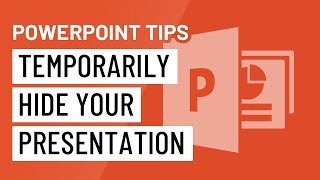Mastering the Art of Temporarily Hiding Your Presentation in PowerPoint: A Comprehensive Guide

Microsoft PowerPoint has long been the go-to software for creating captivating presentations that engage and inform audiences. From business meetings to academic lectures, PowerPoint serves as a versatile tool for conveying information effectively. However, there are instances where presenters may need to temporarily hide their presentation during a live session. Whether it’s to address a question, take a break, or transition to another topic, knowing how to hide your presentation seamlessly can enhance your professionalism and keep your audience focused. In this comprehensive guide, we will delve into various methods and techniques for temporarily hiding your presentation in PowerPoint.
Why Temporarily Hide Your Presentation?
Before we delve into the intricacies of hiding your presentation in PowerPoint, it’s essential to understand the rationale behind this action. Temporarily hiding your presentation can serve several purposes, including:
- Facilitating Audience Engagement: Hiding your presentation allows you to interact with your audience without visual distractions, fostering better engagement and communication.
- Addressing Questions or Concerns: When fielding questions or addressing concerns from your audience, temporarily hiding the presentation can shift the focus to the discussion at hand.
- Transitioning Between Topics: If you need to transition between different sections or topics within your presentation, temporarily hiding the slides can create a smoother segue.
- Taking Breaks: During longer presentations or workshops, hiding the presentation temporarily provides an opportunity for both the presenter and the audience to take short breaks without interrupting the flow.
Methods for Temporarily Hiding Your Presentation:
PowerPoint offers several methods for temporarily hiding your presentation, each catering to different scenarios and preferences. Let’s explore these methods in detail:
1. Slide Show Mode:
- One of the simplest ways to temporarily hide your presentation is by entering Slide Show mode.
- Press F5 on your keyboard or click on the Slide Show tab and select From Beginning or From Current Slide.
- While in Slide Show mode, you can temporarily hide your slides by pressing the B key on your keyboard, which displays a blank screen. Pressing B again will resume the presentation from where you left off.
2. Black Screen Shortcut:
- In addition to the blank screen option (B key), PowerPoint offers a black screen shortcut.
- Pressing the W key on your keyboard displays a black screen, effectively hiding your presentation temporarily.
- Press W again to return to your slides.
3. Custom Slide:
- Another method involves creating a custom slide specifically for hiding your presentation temporarily.
- Create a new slide and fill it with a solid color or an image that serves as a placeholder.
- During your presentation, navigate to this custom slide to hide your content temporarily.
4. Window Minimization:
- If you’re using PowerPoint in windowed mode (not full screen), you can minimize the PowerPoint window to hide your presentation temporarily.
- Simply click on the minimize button (underscore symbol) in the top-right corner of the PowerPoint window.
- To restore the window, click on the PowerPoint icon in the taskbar.
5. Slide Navigation:
- Utilize slide navigation to jump to a specific slide that doesn’t contain content, effectively hiding your presentation.
- For example, create a hidden slide at the end of your presentation or use a blank slide as a placeholder for hiding your content.
Best Practices for Temporarily Hiding Your Presentation:
While hiding your presentation temporarily can be a useful technique, it’s essential to employ best practices to ensure a seamless and professional experience for both you and your audience. Here are some tips to consider:
- Practice Beforehand: Familiarize yourself with the various methods for hiding your presentation and practice switching between them to ensure smooth transitions during your presentation.
- Communicate with Your Audience: Inform your audience before hiding your presentation temporarily to avoid confusion. Clearly communicate the purpose and duration of the break or transition.
- Maintain Engagement: While your presentation is hidden, continue engaging with your audience through verbal communication, questions, or discussions to keep them actively involved.
- Be Prepared to Resume: Anticipate when you’ll need to resume your presentation and be ready to transition back seamlessly. Practice transitioning from hidden mode back to your slides smoothly.
- Use Visual Cues: If necessary, provide visual cues or signals to indicate to your audience when you’re about to hide or resume your presentation, such as a countdown timer or a brief announcement.
Conclusion:
Mastering the art of temporarily hiding your presentation in PowerPoint is a valuable skill that can enhance your presentation delivery and audience engagement. Whether you’re addressing questions, transitioning between topics, or taking a break, knowing how to seamlessly hide your slides ensures a professional and polished presentation experience. By employing the methods and best practices outlined in this guide, you can effectively manage the flow of your presentation and keep your audience focused and engaged throughout. So, the next time you find yourself needing a momentary pause during your PowerPoint presentation, remember these techniques to hide your content temporarily with confidence and ease.





